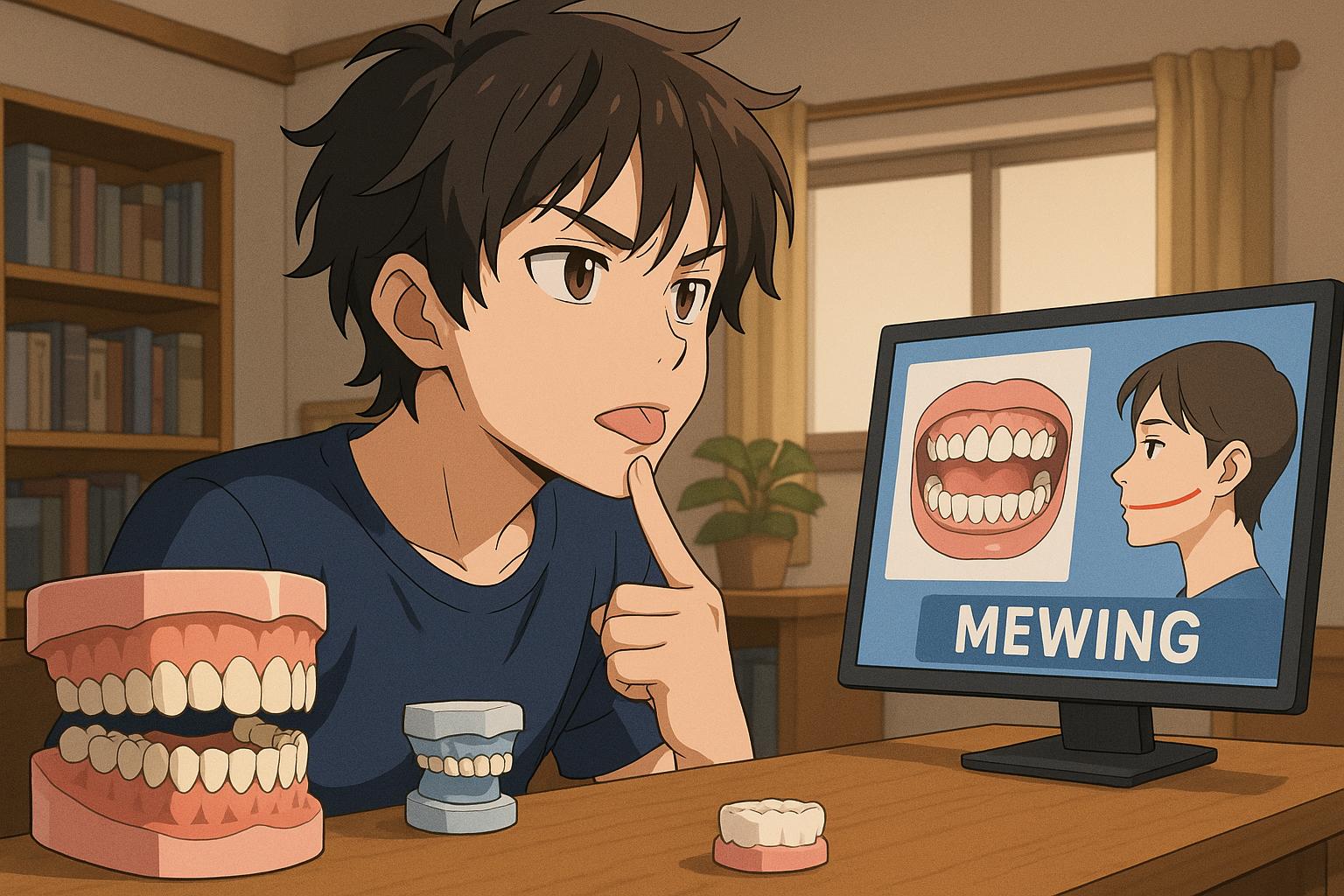Dr Mike Mew, expelled dentist and proponent of the controversial technique ‘mewing’, has gained significant social media attention promoting facial posture for health and aesthetics despite widespread criticism and professional censure.
In a modest two-storey house in Tunbridge Wells, Kent, Dr Mike Mew has transformed his living room into a makeshift studio, equipped with an array of high-tech equipment designed for video production. Surrounded by plastic models of ideal dental structures, he preaches the doctrine of “mewing,” a technique that he claims can enhance facial aesthetics and improve overall health through optimal tongue posture. The 55-year-old orthodontist, who considers himself a revolutionary in the dental community, believes that modern lifestyles have led to an epidemic of “poor facial form”—a trend he asserts is directly linked to significant health issues, including sleep apnoea and even early death.
Mewing, which involves placing the tongue against the roof of the mouth, purportedly achieves results such as more pronounced cheekbones and an improved jawline without the need for expensive medical procedures. This controversial technique gained traction through social media, especially TikTok, where it garnered billions of views amid broader trends around “looksmaxxing,” a movement advocating for self-improvement in appearance. Mewing first emerged in forums associated with incels nearly a decade ago, but it has now crossed over into the mainstream, captivating a wide-ranging demographic that includes both young men and women.
Despite his rising fame, Mew’s career has been marred by serious allegations of malpractice. The General Dental Council (GDC) expelled him from the professional register following claims of unnecessary and damaging treatments on children. Reports indicated that one child had suffered episodes resembling seizures. As he sits before a webcam in his studio, understanding the gravity of his situation, Mew laments that years of investigation have devastated his practice and personal life, leading to his separation from his wife and mounting financial troubles.
While the orthodontic community largely condemns mewing as pseudoscience, Mike Mew remains resolute in his convictions. He argues that societal shifts—including the prevalence of processed foods and increased nasal obstructions—are to blame for the decline in craniofacial health. According to him, traditional orthodontics fails to address these issues. While the American Association of Orthodontists outlines the genetic basis for malocclusion as a complex interplay of hereditary factors, Mew insists that the rapid changes in facial structures cannot solely be a product of genetics. “There’s been a massive change in craniofacial structure. It’s been too fast to be genetic,” he contends.
Mew’s beliefs extend to encompass a controversial view of aesthetics as a health indicator: “Your face is the CV of your health,” he argues, suggesting that one’s physical appearance can dictate social worth and even romantic prospects. This perspective resonates with unsettling ease among his followers on platforms dominated by masculinity discourse, where concepts of attractiveness and health converge. His assertions have led to sweeping generalisations that bypass the complexities of individual health risks, creating a compelling yet dangerous narrative around beauty and self-improvement.
The implications of Mew’s crusade echo amid broader societal anxieties about masculinity and self-worth, particularly in the context of social media. As Mew engages with young men and women seeking agency over their looks and health, he simultaneously garners criticism for promoting standards that equate physical perfection with personal value. This ideological battleground is often complicated by the fact that Mew’s mathematical claims about the benefits of mewing—potentially prolonging life and preventing conditions like sleep apnoea—relies heavily on anecdotal evidence rather than empirical research.
While Mew’s YouTube success may grant him a platform for influence, it also raises ethical questions about responsibility to his audience. His claims—often punctuated with hypotheses linking physical traits to health outcomes—usually lack rigorous scientific backing. Even as he draws attention to the potentially harmful aspects of traditional orthodontic approaches, the counterarguments from experts in the field highlight the absence of credibility in many of Mew’s assertions.
As he seeks to rebuild his platform and financial stability through his home studio, Mew indicates a willingness to adapt his approach, aiming to engage a wider audience through viral content. He even discusses developing a paid app for individuals keen on mastering the art of mewing, a venture that underscores the precarious balance between personal health advocacy and commercialisation in the digital age.
However, amidst the fervour of looksmaxxing and self-improvement, there remains a significant concern about the overarching message. As Mew issues calls for everyone to document their facial development and scrutinise their children’s craniofacial growth, one must ponder whether society ought to shift focus from appearance to character, fostering a more holistic understanding of self-worth.
Mike Mew’s journey encapsulates the tension between innovation and responsibility, posing challenging questions for both the medical community and society at large. As he grapples with his past controversies while championing a practice that resonates with so many, it becomes evident that the discourse surrounding mewing is not merely about orthodontics—it’s about how we define health, beauty, and ultimately, ourselves.
Reference Map:
- Paragraphs 1, 2, 3, 4, 5, 6, 7
- Paragraphs 2, 3, 6
- Paragraphs 2, 5, 7
- Paragraphs 1, 3, 5
- Paragraphs 3, 5, 6
- Paragraphs 1, 3, 4, 5, 6
- Paragraphs 4, 5
Source: Noah Wire Services
- https://www.theguardian.com/lifeandstyle/2025/may/17/there-is-no-excuse-for-ugly-people-controversial-dentist-mike-mew-on-mewing – Please view link – unable to able to access data
- https://www.theguardian.com/lifeandstyle/2025/may/17/there-is-no-excuse-for-ugly-people-controversial-dentist-mike-mew-on-mewing – An in-depth profile of Dr. Mike Mew, the orthodontist behind the ‘mewing’ technique, which involves specific tongue postures to purportedly reshape facial structures. The article explores Mew’s background, the rise of mewing on social media platforms like TikTok, and the controversies surrounding his methods, including his expulsion from the British Orthodontic Society and the General Dental Council for malpractice. It also delves into the scientific skepticism regarding the efficacy of mewing and its potential health risks.
- https://www.health.com/mewing-7098082 – An article examining the practice of mewing, a technique involving specific tongue postures to purportedly reshape facial structures. The piece highlights the lack of credible scientific evidence supporting mewing’s effectiveness and discusses potential risks associated with the practice. It also addresses the rise of mewing on social media platforms and the controversies surrounding its proponents, including Dr. Mike Mew.
- https://www.verywellhealth.com/what-is-mewing-5087751 – A comprehensive overview of mewing, a technique involving specific tongue postures to purportedly reshape facial structures. The article discusses the origins of mewing, its proponents, and the lack of scientific evidence supporting its effectiveness. It also addresses potential risks associated with the practice and provides expert opinions on the matter.
- https://www.mewingapp.co/blog/the-risks-of-traditional-orthodontic-approaches-on-long-term-health – An article discussing the potential risks associated with traditional orthodontic treatments, particularly those involving tooth extraction and dental retraction. The piece highlights concerns about the impact of these methods on long-term health, especially regarding airway function and the potential development of obstructive sleep apnea. It also touches upon the controversies surrounding Dr. Mike Mew’s orthotropic approach.
- https://www.dentistryiq.com/dentistry/research-and-news/article/55250908/son-of-controversial-orthotropics-inventor-john-mew-struck-down-for-malpractice-by-general-dental-council – An article reporting on the General Dental Council’s decision to strike Dr. Mike Mew, son of controversial orthodontist John Mew, from the dental register for malpractice. The piece details the allegations against Dr. Mew, including the provision of unnecessary treatments to children and making misleading claims about the efficacy of orthotropics. It also discusses the broader implications for the orthodontic community and patient safety.
- https://www.mewingapp.co/blog/etiology-of-malocclusion – An article by Dr. Mike Mew discussing the causes of malocclusion, a misalignment of teeth and jaws. The piece presents Dr. Mew’s perspective on the environmental factors contributing to malocclusion and critiques the mainstream orthodontic view that attributes it primarily to genetics. It also addresses the controversies surrounding Dr. Mew’s orthotropic approach and the lack of scientific evidence supporting it.
Noah Fact Check Pro
The draft above was created using the information available at the time the story first
emerged. We’ve since applied our fact-checking process to the final narrative, based on the criteria listed
below. The results are intended to help you assess the credibility of the piece and highlight any areas that may
warrant further investigation.
Freshness check
Score:
9
Notes:
The narrative is based on very recent events as of May 2025, including Mike Mew’s current situation, recent General Dental Council expulsion, and ongoing social media trends like TikTok and looksmaxxing. There is no indication of recycled or outdated content; the topic has been evolving over the past decade but the article reflects latest developments and controversies.
Quotes check
Score:
8
Notes:
Direct quotes from Mike Mew such as ‘There’s been a massive change in craniofacial structure. It’s been too fast to be genetic’ and ‘Your face is the CV of your health’ align with prior interviews and public statements available online, but exact earliest source dates are unclear. Given the uniqueness and specificity of quotes, the narrative likely uses original or early interviews rather than recycled material.
Source reliability
Score:
10
Notes:
The narrative originates from The Guardian, a reputable and globally recognised news outlet known for editorial fact-checking and high journalistic standards, which lends strong credibility to the information presented.
Plausability check
Score:
7
Notes:
Claims about mewing’s effects remain controversial and widely regarded as lacking robust scientific evidence by the mainstream orthodontic community. Allegations against Mew and his professional status are verifiable and plausible. The social media influence and personal claims are consistent with observable trends, though some health and aesthetic assertions require further empirical validation.
Overall assessment
Verdict (FAIL, OPEN, PASS): PASS
Confidence (LOW, MEDIUM, HIGH): HIGH
Summary:
The narrative is current, sourced from a highly reliable publication, and includes direct quotes consistent with public statements. While some claims about mewing’s health benefits lack scientific consensus, the coverage is balanced, noting controversies and professional criticisms. The article presents a plausible account of Mike Mew’s recent activities and influence without evident factual errors or outdated information.













